Coastal Carolina's Two-Headed Backfield
Keep an eye on what the Chanticleers are doing with their running backs
If you like the Outside Zone Newsletter’s free dispatches, you’ll probably like the premium ones even more, featuring a game review on Monday and a preview (with ATS pick) on Friday, every week. Subscribe now for $5 a month or a discounted $50 a year!
You could be forgiven for not being especially aware of the inner machinations of Coastal Carolina’s offense. Hell, you could even be forgiven for not realizing that two-time FCS Coach of the Year finalist Jamey Chadwell is in charge at Coastal and that he’s brought with him essentially his entire staff from Charleston Southern. At Charleston Southern, Chadwell built a team that won 35 games in four years from 2013-2016 before departing for the offensive coordinator job under Joe Moglia at Coastal Carolina.
Since taking over for Moglia last spring following his retirement from coaching, Chadwell hasn’t drawn a ton of attention to himself. The Chanticleers went 5-7 in Chadwell’s first season and didn’t really do anything well enough to merit any sort of acclaim, while most of the heat for an upstart football program in the Carolina region has gone to Will Healy’s Charlotte. As I said, you can be forgiven for not being up to date on the latest in Coastal Carolina football.
Not anymore, however. After a few years out in the football desert, so-to-speak, Coastal Carolina looks a whole lot like a program ready to stake its claim as one of the best in the Sun Belt, and as a program worth paying attention to, especially on the offensive side of the football.
It isn’t just because of production, either. This offense has certainly put up big numbers through three games, averaging 44.3 points a game as it has throttled Kansas, Campbell and Arkansas State in the season’s opening stanza, but the intrigue here is in the way the offense is actually built. While so many schools are running a basic variation of the exact same spread, RPO offense right now, Coastal Carolina has a twist to the way that it does things that makes it, in this writer’s opinion, one of the most entertaining offenses in America.
The variation that Chadwell and co-coordinators Newland Isaac and Willy Korn is built around the backfield, where Coastal Carolina frequently deploys unique two-back, split backfield looks, with those two halfbacks lining up all over in the backfield along with quarterback Grayson McCall. Without a ton of talent at receiver, Coastal Carolina does runs a ton of 21 personnel, because it means getting two very good halfbacks in Torrance Marable and Shermari Jones along with a good tight end in Isaiah Likely all onto the field at the same time. This is mostly a running team on top of that, so the extra blocking on the field goes a long way for creating space for the ball carrier.
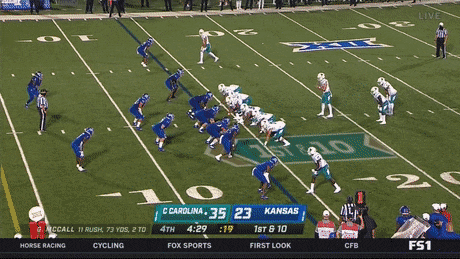
Off of that two-halfback look, Coastal Carolina boasts what appears to be roughly 5,000 different looks, all based around slight variations to the traditional triple option concepts that I’ve talked about ad nauseum on this newsletter before, including some variations that look to be directly influenced by Oklahoma’s wishbone.
This is the most traditional of the bunch, if you can call any of this traditional. Coastal Carolina lines up in its most common two-back look, with one back offset next to the quarterback and another behind, splitting the halfback and the quarterback, almost like a pistol look. The offensive line is zone blocking to the field with the right guard slipping out on a pull.
He’s doing that because the zone blocking elsewhere is leaving the defensive end unaccounted for, as you usually would on an option play like this one. However, the key of the pulling guard here is that if the end stays and forces a handoff, the guard is there to seal him off to give the halfback a better path into the defense, without the risk of being caught from behind.
If that end bites in and looks to stop the handoff, forcing the quarterback onto his speed option read to the outside, that guard can run free off the edge, working as a lead blocker that can either take on the play side linebacker or second read-defender, which is the unblocked cornerback on this play. Meanwhile, the wide receiver lined head-up on that corner can get into the second-level and take on a safety.
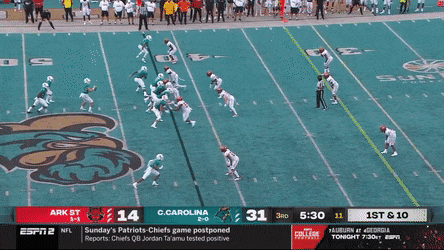
When I say that there’s a ton of variations on this base concept, I want to emphasize just how serious I am when I say it. This is not variation based on the reads in the play. Coastal Carolina will change which running back is designated for the first and second reads seemingly at random, which I’m sure there’s a real reason for, but the best explanation I can find is that it drives the defense insane.
You get that same triple option concept here, but the deep halfback is the first read on this one rather than the offset halfback, who slips out on that speed option look. Also, there’s no pulling guard on this one, rather, the tight end on the play side of the line pops out into the flats as if he’s running a route and then cuts back in once the read cornerback jumps too far inside to seal him off. This one doesn’t go for a huge gain, but it’s still really well-designed and a great complement to some of the other option looks. Being able to mix timing up like this just by switching the reads slightly can really throw off a defense.
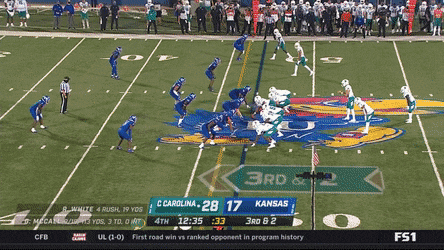
Outside of the more typical triple option looks, Coastal Carolina really shines on these two-back sets (and that Wishbone influence really shines through). This is a speed option for the quarterback and deep halfback, with that offset back as a lead blocker, just as Oklahoma used to do with its non-ball carrying backs on option plays.
The play side outside linebacker is being isolated this time, with the tight end lined up in slipping right past to get to that nickel safety and prevent him from blowing up the play. Because Kansas was so used to seeing an inside read from this formation, the insider linebacker takes himself out of the play completely trying to stuff the middle, meaning that the back side outside linebacker is the last player in the second-level that can make a play. He’s not there quick enough, so McCall is just able to breeze past the read linebacker (who plays the pitch man) and follow behind his tight end and offset lead blocker halfback to pick up a big gain on his own. Well-designed, using the defense’s instincts against it. Again.
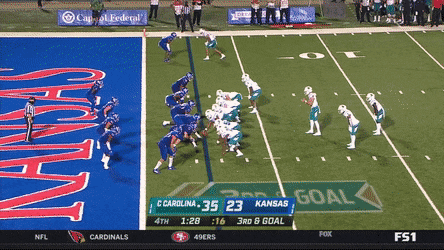
While all of this is great and works very well, it’s time to talk about my favorite thing that Coastal Carolina does in the running game. I’m sure there’s a real name for it, but I’m going to call it a counter option, because the misdirection happening in the backfield is designed around the same basic fundamentals that a counter play has.
This is that speed option again, with the offset halfback leading the way for the deep halfback, except there’s a twist in the backfield that completely fools literally every defender on the field: the entire offense sells an option to the strong side of the field, rather than to the weak side, which has no blockers.
McCall opens to the strong side, as if he’s doing the usual first-read on a triple option to the deep back, who gives a hard step in before cutting outside to work as the pitch man again. The offset back does the same kind of fake, turning his whole body to the strong side of the field before cutting back out to be the lead blocker down the field.
Even the line sells it. Everything that the offense is doing here is telling the defense to get downhill to the field as fast as it can, to meet that pitch man on the perimeter before he can get to the end zone. The linebackers on the “back side” (which is actually the play side) dive into the pile to stop an inside handoff, leaving just one player on the actual play side outside of the isolated read defender. He’s picked up by the lead blocker halfback and Coastal Carolina has an absurdly easy touchdown because of it.
This is perfect. They only run it once or twice a game, but I support committing to the bit and this is full commitment to completely fucking over the defense in every possible way.
The rushing game is the better part of this offense, but I’d be remiss if I didn’t at least mention the passing game. This is primarily a play action offense (duh), but I love the way that Isaac and Korn scheme open receivers by drawing defender’s eyes with action elsewhere.
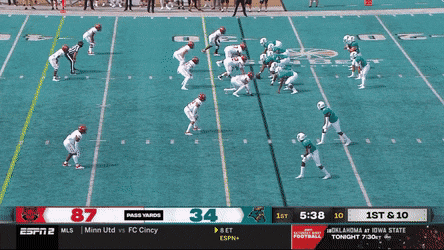
This is a great example. Everybody loves the play action wheel route from a split backfield, but that’s too obvious for Coastal Carolina. The defense picks that out from the beginning and covers the wheel with an outside corner, who breaks off his usual cover 2 responsibilities to keep up.
The deep safety on that side, however? He thinks he’s safe with the corner picking up the wheel, and keeps his eyes in the backfield for just a tick too long, as the tight end sneaks off the line completely undetected and into the secondary. He’s well past the safety by the time he realizes what has happened, and McCall puts the ball right where it needs to be. Football is a whole lot easier for a quarterback with plays like this one.
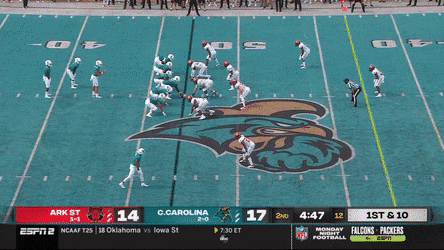
It doesn’t end in a completion here, but this is the same idea. The offense really sells the obvious play, which is a pass into the halfback in the flats off of the play fake in the backfield, which draws the flats defender in. In doing that, he leaves the outside receiver completely unaccounted for on a go route, and the safeties are forced to pick up the slack and cover him down the field. If McCall throws this ball earlier it’s easily complete, but even this should have been caught.
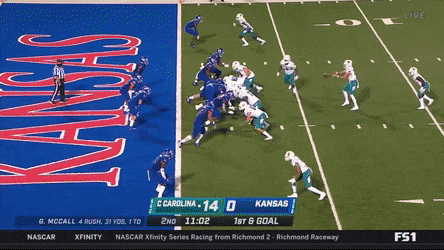
This is the foundation of the whole passing attack. Everything looks like something else, until the defense goes to defend that, and then there’s suddenly a tight end 30 yards down the field without a defender in sight. This play looks exactly like split zone, down to the tight end dragging behind the line to take on the isolated defensive end.
The defense reads split zone (because that’s what it is), plays inside to stop it, and then the tight end moves right past that defensive end, McCall dumps off a shovel pass and Kansas’ defensive coordinator pulls all of the hair out of his head.
This is all brilliant. It’s built to work in tandem, everything is setting something else up, and the defense is unable to quickly identify what’s happening because the offense has run five different plays out of the same exact look on the last five downs. There’s no good way to stop a split zone shovel pass because a split zone shovel pass isn’t something that normally happens, so there’s no good reason to prepare for it unless you’re a crazy person. I don’t know if Coastal Carolina has the talent yet to truly challenge for the top of the Sun Belt, but with an offense this good, I wouldn’t be surprised at all to see this team sitting atop the conference very soon. You might not have been watching Coastal Carolina before, but you absolutely should be now.
Up next: Someone please talk me out of trusting Miami in a big game


